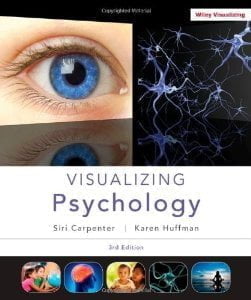Test Bank for Visualizing Psychology, 3rd Edition : Carpenter
$35.00 Original price was: $35.00.$26.50Current price is: $26.50.
Test Bank for Visualizing Psychology, 3rd Edition : Carpenter
Test Bank for Visualizing Psychology, 3rd Edition : Carpenter

Product details:
- ISBN-10 : 1118449789
- ISBN-13 : 978-1118449783
- Author: Siri J. Carpenter
Visualizing Psychology, Third Edition helps students examine their own personal studying and learning styles with several new pedagogical aids–encouraging students to apply what they are learning to their everyday lives while offering ongoing study tips and psychological techniques for mastering the material. Most importantly, students are provided with numerous opportunities to immediately access their understanding.
Table contents:
1 Introduction and Research Methods 2
Introducing Psychology 4
Psychology’s Four Main Goals 4
Careers in Psychology 5
Origins of Psychology 7
Psychology’s Past 7
Modern Psychology 8
What a Psychologist sees: The Biopsychosocial Model 11
The Science of Psychology 12
The Scientific Method 12
Ethical Guidelines 12
Research Methods 15
Experimental Research 15
Descriptive Research 18
Correlational Research 19
Biological Research 23
Strategies for Student Success 23
Study Habits 23
Visual Learning 24
Time Management 25
Applying Psychology: Improving Your Grade 25
Psychological Science: Serious Problems with Multitasking 26
2 Neuroscience and Biological Foundations 32
Our Genetic Inheritance 34
Behavioral Genetics 34
Evolutionary Psychology 37
Neural Bases of Behavior 38
How Do Neurons Communicate? 39
Hormones and the Endocrine System 42
Nervous System Organization 44
Central Nervous System (CNS) 44
Applying Psychology: Testing for Reflexes 47
Peripheral Nervous System (PNS) 47
What a Psychologist sees: Autonomic Nervous System and Sexual Arousal 49
A Tour Through the Brain 50
Lower-Level Brain Structures 50
The Cerebral Cortex 53
Psychological Science: Phineas Gage—Myths Versus Facts 55
Two Brains In One? 57
What a Psychologist sees: Split-Brain Research 58
3 Stress and Health Psychology 64
Understanding Stress 66
Sources of Stress 66
Applying Psychology: Measuring Life Changes 67
Effects of Stress 69
Stress and Illness 72
Psychological Science: Does Stress Cause Gastric Ulcers? 72
Cancer 73
Cardiovascular Disorders 73
Posttraumatic Stress Disorder (PTSD) 75
Health Psychology and Stress Management 76
What Does a Health Psychologist Do? 76
What a Psychologist sees: Nicotine and the Biopsychosocial Model 77
Coping with Stress 78
Applying Psychology: Progressive Relaxation 81
Resources for Healthy Living 81
4 Sensation and Perception 86
Understanding Sensation 88
Processing 89
Psychological Science: Subliminal Perception 91
Sensory Adaptation 92
How We See and Hear 93
Vision 94
Hearing 94
Our Other Important Senses 98
Smell and Taste 98
What a Psychologist sees: Enjoying Pizza—A Complex Experience 99
The Body Senses 100
Understanding Perception 101
Applying Psychology: Optical Illusions 102
Selection 102
Organization 104
Applying Psychology: Color Aftereffects 109
Interpretation 110
5 States of Consciousness 118
Consciousness, Sleep, and Dreaming 120
Circadian Rhythms 121
Applying Psychology: Sleep Deprivation 122
Stages of Sleep 122
Why Do We Sleep and Dream? 124
Sleep Disorders 126
Psychological Science: Dream Variations and Similarities 127
Applying Psychology: Natural Sleep Aids 128
Psychoactive Drugs 130
Four Drug Categories 132
Club Drugs 137
Meditation and Hypnosis 137
Meditation 137
What a Psychologist sees: Benefits of Meditation 138
Hypnosis 139
6 Learning 146
Classical Conditioning 148
Beginnings of Classical Conditioning 148
What a Psychologist sees: Conditioning Fear 150
Understanding Classical Conditioning 151
Operant Conditioning 155
Beginnings of Operant Conditioning 156
Reinforcement 156
What a Psychologist sees: Partial Reinforecement Keeps ‘em Coming Back 158
Punishment 160
Applying Psychology: Problems with Punishment 161
Cognitive-Social Learning 163
Insight and Latent Learning 163
Observational Learning 164
Psychological Science: Bandura’s Bobo Doll 165
Biology of Learning 167
Neuroscience and Learning 167
Mirror Neurons and Imitation 167
Evolution and Learning 168
7 Memory 174
The Nature of Memory 176
Memory Models 176
Sensory Memory 177
Applying Psychology: Demonstrating Iconic and Echoic Memory 178
What a Psychologist sees: Chunking in Chess 179
Short-Term Memory (STM) 179
Long-Term Memory (LTM) 180
Applying Psychology: Mnemonic Devices 182
Improving Long-Term Memory 182
Forgetting 185
Theories of Forgetting 185
Psychological Science: How Quickly We Forget 186
Factors Involved in Forgetting 187
Biological Bases of Memory 189
Neuronal and Synaptic Changes 189
Hormonal Changes and Emotional Arousal 190
Where Are Memories Located? 190
Biological Causes of Memory Loss 191
Memory Distortions 192
Applying Psychology: A Memory Test 193
Memory and the Criminal Justice System 193
False Versus Repressed Memories 194
8 Thinking, Language, and Intelligence 200
Thinking 202
Cognitive Building Blocks 202
Solving Problems 203
Barriers to Problem Solving 205
Creativity 206
Applying Psychology: Are You Creative? 207
Language 208
What a Psychologist sees: Language and the Brain 209
Language and Thought 209
Language Development 210
Can Humans Talk with Nonhuman Animals? 212
Intelligence 213
Do We Have One or Many Intelligences? 213
Emotional Intelligence 215
Measuring Intelligence 215
The Intelligence Controversy 218
Extremes in Intelligence 218
The Brain’s Influence on Intelligence 219
Genetic and Environmental Influences on Intelligence 220
What a Psychologist sees: Family Studies of Intelligence 220
Psychological Science: Stereotype Threat 222
9 Lifespan Development I 228
Studying Development 230
Theoretical Issues 230
Psychological Science: Deprivation and Development 231
Research Approaches 232
Physical Development 234
Prenatal and Early Childhood 234
What a Psychologist sees: How an Infant Perceives the World 239
Adolescence and Adulthood 240
Cognitive Development 243
Stages of Cognitive Development 244
Applying Psychology: Putting Piaget to the Test 248
What a Psychologist sees: Brain and Behavior in Adolescence 249
Vygotsky Versus Piaget 250
10 Lifespan Development II 256
Social, Moral, and Personality Development 258
Social Development 258
What a Psychologist sees: The Power of Touch 258
Applying Psychology: What’s Your Romantic Attachment Style? 260
Parenting Styles 260
Moral Development 261
Personality Development 264
How Sex, Gender, and Culture Affect Development 266
Sex and Gender Influences on Development 266
Cultural Influences on Development 270
Developmental Challenges Through Adulthood 272
Committed Relationships 272
Applying Psychology: Are Your Relationship Expectations Realistic? 273
Psychological Science: The Power of Resilience 274
Work and Retirement 274
Death and Dying 276
11 Motivation and Emotion 282
Theories of Motivation 284
Biological Theories 284
Applying Psychology:Sensation Seeking 287
Psychosocial Theories 287
Biopsychosocial Theories 288
Motivation and Behavior 289
Hunger and Eating 289
Achievement 294
Sexuality 295
Extrinsic Versus Intrinsic Motivation 297
Components and Theories of Emotion 299
Three Components of Emotion 299
Three Major Theories of Emotion 301
Psychological Science: Schachter and Singer’s Classic Study 302
What a Psychologist sees: Fast and Slow Pathways for Fear 304
Culture, Evolution, and Emotion 304
The Polygraph as a Lie Detector 306
12 Personality 312
Psychoanalytic/Psychodynamic Theories 314
Freud’s Psychoanalytic Theory 314
Psychodynamic/Neo-Freudian Theories 318
Evaluating Psychoanalytic Theories 319
Trait Theories 319
Early Trait Theorists 320
Modern Trait Theory 320
Evaluating Trait Theories 320
Psychological Science: Mate Preferences and the Five-Factor Model (FFM) 321
Applying Psychology: Personality and Your Career 322
Humanistic Theories 323
Rogers’s Theory 323
Maslow’s Theory 324
Evaluating Humanistic Theories 325
Social-Cognitive Theories 326
Bandura’s and Rotter’s Approaches 326
Evaluating Social-Cognitive Theories 237
Biological Theories 328
Three Major Contributors to Personality 328
Evaluating Biological Theories 328
The Biopsychosocial Model 329
Personality Assessment 330
Interviews and Observation 330
Objective Tests 330
Projective Tests 332
Are Personality Measurements Accurate? 332
What a Psychologist sees: Projective Tests 333
13 Psychological Disorders 340
Studying Psychological Disorders 342
Explaining Abnormality 343
What a Psychologist sees: Seven Psychological Perspectives on Abnormal Behavior 344
Classifying Abnormal Behavior 345
Understanding and Evaluating the DSM 346
Anxiety Disorders 348
Four Major Anxiety Disorders 348
Explaining Anxiety Disorders 350
Mood Disorders 352
Understanding Mood Disorders 352
Explaining Mood Disorders 354
Applying Psychology: How Can
You Tell If Someone is Suicidal? 354
Schizophrenia 355
Symptoms of Schizophrenia 356
Types of Schizophrenia 357
Explaining Schizophrenia 358
Other Disorders 361
Dissociative Disorders 361
Personality Disorders 362
How Gender and Culture Affect Abnormal Behavior 364
Gender Differences 364
Psychological Science: Gender Differences in Internalizing Versus Externalizing 365
Culture and Schizophrenia 366
Avoiding Ethnocentrism 366
14 Therapy 374
Talk Therapies 376
Psychoanalysis/Psychodynamic Therapies 377
Humanistic Therapies 379
Cognitive Therapies 381
What a Psychologist sees: Ellis’s Rational-Emotive Behavior Therapy (REBT) 383
Behavior Therapies 384
Classical Conditioning 384
Operant Conditioning 386
Observational Learning 386
Evaluating Behavior Therapies 387
Biomedical Therapies 387
Psychopharmacology 388
Electroconvulsive Therapy and Psychosurgery 390
Evaluating Biomedical Therapies 391
Psychotherapy in Perspective 391
Therapy Goals and Effectiveness 392
Applying Psychology: Choosing a Therapist 393
Therapy Formats
Psychological Science: Therapy—Is There an App for That? 395
Cultural Issues in Therapy 395
Gender and Therapy 396
15 Social Psychology 402
Social Cognition 404
Attributions 404
Attitudes 406
Psychological Science: Cognitive Dissonance 406
Social Influence 408
Conformity 408
Applying Psychology: Cultural Norms for Personal Space 409
Obedience 410
Group Processes 413
What a Psychologist sees: How Groupthink Occurs 416
Social Relations 417
Prejudice and Discrimination 417
Aggression 420
Altruism 420
Interpersonal Attraction 423
What a Psychologist sees: Love over the Lifespan 426
Appendix A: Statistics and Psychology 432
Appendix B: Answers to Learning Objectives 440
Appendix C: Answers to Identify the Research Method Questions and Self-Tests 458
People also search:
Visualizing Psychology
Visualizing Psychology Carpenter
Visualizing Psychology Carpenter 3rd
Visualizing Psychology Carpenter 3rd Test Bank
Test Bank for Visualizing Psychology, 3rd Edition : Carpenter Download
Related products
Test Bank
Test Bank for Clinical Immunology and Serology A Laboratory Perspective, 3rd Edition: Stevens
Test Bank
Test Bank for Operating Systems: Internals and Design Principles, 7th Edition: William Stallings
Test Bank
Test Bank for Decision Support and Business Intelligence Systems, 9th Edition: Efraim Turban











